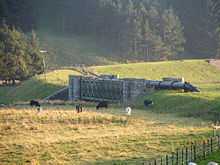Talla Railway
| Talla Railway | ||||||||||||||||||||||||||||||||||||
|---|---|---|---|---|---|---|---|---|---|---|---|---|---|---|---|---|---|---|---|---|---|---|---|---|---|---|---|---|---|---|---|---|---|---|---|---|
| ||||||||||||||||||||||||||||||||||||
Legend | ||||||||||||||||||||||||||||||||||||
| ||||||||||||||||||||||||||||||||||||

The Talla Railway was a reservoir construction railway in Scotland active from 1897 to 1910. Located in the Scottish Borders, its most substantial engineering feature was the Tweed Viaduct, a 100-foot (30 m) girder bridge across the River Tweed.
Route

Starting from Caledonian Railway metals at Rachan Junction, near Broughton station (originally part of the Symington, Biggar and Broughton Railway's network), the railway followed the route of the River Tweed and what is now the A701 closely for 8 miles (13 km) in a southerly direction. It extended to Victoria Lodge, the headquarters for the dam's construction. An intermediate stop with wooden platforms was later established at Crook Halt, to serve the Crook Inn.
History
The Edinburgh and District Water Trust built the railway to assist construction of the Talla Reservoir which lies 1000 feet (300 m) above sea level and was built to supply Edinburgh with water. Construction was by James Young & Sons. On 29 September 1897 a stone-laying ceremony marked the start of construction of Victoria Lodge, at the southern terminus. The building is now a private house. Material was lifted from there to the construction site by a ropeway, called a "Blondin" after the famous tightrope walker Charles Blondin.
The Caledonian Railway was persuaded to double the line from Broughton Station to Rachan Junction, and also built a new platform at Broughton.
Materials delivered included stone and aggregates from quarries in North Queensferry and Craigleith, pipes, valve gear and pumping equipment from central Scotland, as well as the puddle clay from the Carluke area, plus gravel and sand. Over 100,000 tons of material were transported for the building of the reservoir. The Tweed Viaduct, a 100-foot (30 m) girder bridge, carried the railway and water pipeline across the River Tweed at Glenrusco to the north of Tweedsmuir. The abutments are faced with granite from Italy.
When James Young & Sons went bankrupt in 1899, the main contract was taken over by John Best of Leith, who had been one of the main sub-contractors on the project, the other being Robert McAlpine & Sons. Best opened a halt at Crook Siding, close to the Crook Inn, which proved very popular with workers returning after their work, who would stop there for refreshments. Best had shrewdly bought a share of the inn prior to this.
As the reservoir neared completion, run-down of the line started in 1904. The reservoir opened on 20 May 1905, and the railway closed soon afterwards. It was sold for scrap in 1910 and all track had been lifted by 1912.
The Tweed Viaduct still carries the water pipe, which is still in use and supplies water from the reservoir to Edinburgh, 28 miles (45 km) to the north.
Sources
- Awdry, Christopher (1990). Encyclopaedia of British Railway Companies. Sparkford: Patrick Stephens Ltd. ISBN 1-8526-0049-7. OCLC 19514063.
- Furnevel, John (2 February 2006). "The Talla Railway". Railscot. Retrieved 25 March 2013.
